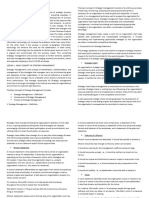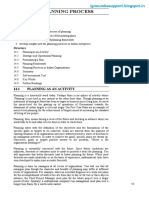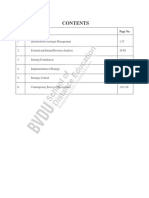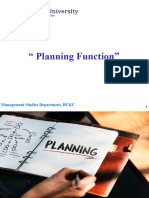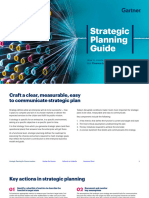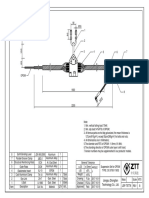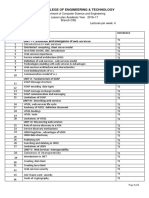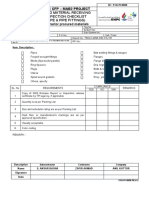0 ratings0% found this document useful (0 votes)
7 viewsEngineering Management
Engineering Management
Uploaded by
Alison AnovaThis document discusses strategic planning concepts. It defines strategic planning as a long-term plan that allows an organization to achieve its objectives by understanding priorities and resources. The document outlines the six key elements of strategic planning: vision, mission, objectives, strategy, approach, and tactics. It also discusses the benefits of robust strategic planning for project managers, such as increased success and efficient resource use.
Copyright:
© All Rights Reserved
Available Formats
Download as PDF, TXT or read online from Scribd
Engineering Management
Engineering Management
Uploaded by
Alison Anova0 ratings0% found this document useful (0 votes)
7 views7 pagesThis document discusses strategic planning concepts. It defines strategic planning as a long-term plan that allows an organization to achieve its objectives by understanding priorities and resources. The document outlines the six key elements of strategic planning: vision, mission, objectives, strategy, approach, and tactics. It also discusses the benefits of robust strategic planning for project managers, such as increased success and efficient resource use.
Original Title
engineering management
Copyright
© © All Rights Reserved
Available Formats
PDF, TXT or read online from Scribd
Share this document
Did you find this document useful?
Is this content inappropriate?
This document discusses strategic planning concepts. It defines strategic planning as a long-term plan that allows an organization to achieve its objectives by understanding priorities and resources. The document outlines the six key elements of strategic planning: vision, mission, objectives, strategy, approach, and tactics. It also discusses the benefits of robust strategic planning for project managers, such as increased success and efficient resource use.
Copyright:
© All Rights Reserved
Available Formats
Download as PDF, TXT or read online from Scribd
Download as pdf or txt
0 ratings0% found this document useful (0 votes)
7 views7 pagesEngineering Management
Engineering Management
Uploaded by
Alison AnovaThis document discusses strategic planning concepts. It defines strategic planning as a long-term plan that allows an organization to achieve its objectives by understanding priorities and resources. The document outlines the six key elements of strategic planning: vision, mission, objectives, strategy, approach, and tactics. It also discusses the benefits of robust strategic planning for project managers, such as increased success and efficient resource use.
Copyright:
© All Rights Reserved
Available Formats
Download as PDF, TXT or read online from Scribd
Download as pdf or txt
You are on page 1of 7
STRATEGIC PLANNING VISION Your strategy
Define your is a long-
is the strategy which vision term plan
defines how the An that enables
organization plans
organization’ you to
to move from its s vision achieve your
current state to the statement is organization’
state envisioned in an s objectives.
its mission and aspirational APPROACH
vision framework description Outline your
Strategic planning of what it approach
focuses on a
wants to An approach
business’s future by achieve in provides a
understanding the future. methodology
operational priorities MISSION for executing
and resource Create your your
availability, setting mission strategy.
out clear strategic While your TACTICS
objectives for vision is an Get down to
desired business organization- tactics
results, and wide goal, Tactics are
developing an action your mission focused
plan on how to how you initiatives,
achieve them. plan to projects, or
allows a business to achieve the programs
take control of its vision. that allow
vision and turn
OBJECTIVES organization
projected results into Set your s to execute
reality. This objectives a strategic
emphasizes its Objectives plan.
importance for are specific
project managers, results that a
who are responsible person or
for the success or Strategic plans outline the
system aims firm's long-range (two to five
failure of a project, to achieve
and for ensuring an years) organizational goals
within a time and
organization frame.
operates at optimal STRATEGY set a course of action the
efficiency Develop firm will pursue to reach its
6 ELEMENTS OF STRATEGIC your goals. These long-term goals
PLANNING strategy
encompass eight major Benefits of robust strategic Increases the
areas of concern: market planning in project likelihood of success
standing, innovation, human management by identifying and
resources, addressing risks
There are numerous
early on
financial resources, physical benefits to robust strategic
Helps to ensure that
resources, productivity, planning, for both the
resources are used
social responsibility, and organization and the project
efficiently and
financial manager. Strategic planning:
effectively, as
performance. A good Helps to ensure that project managers
strategic plan answers: everyone in an can align their
organization is projects with
Where are we aware of the strategic objectives
going? company’s vision The success of a
What is the and objectives, and strategic plan relies
environment? knows how their on the people and
How do we get work contributes to systems involved in
there? these goals its creation. Thus,
Gives direction and it’s vital that the
To answer these questions
focus to project right people are
and establish effective long-
managers, who can involved in the
term goals, managers require
use strategic strategic planning
extensive amounts of objectives as a guide process and that
information. For instance, when making business objectives,
managers must study decisions about as well as how they
priorities, resources, will be achieved, are
Budgets, and risks clearly
Production Facilitates better communicated. To
schedules, communication do this, there should
Industry and between the be a greater sense of
economic data, organization and its accountability.
Customer stakeholders, as Lessons learned in
preferences, everyone is aware of strategic plan
Internal and the strategic development should
external data, direction and how it be incorporated into
Competition and so will be achieved future planning
on. Improves decision- processes, while
making by providing continuously
a framework for redefining the plan
evaluating options to ensure you keep
and trade-offs working towards
achieving your vision Pace Technology, that are derived
and overall formerly known as from forecasting the
priorities. Textron Fleet future. It is a logical
Management, is and systematic
innovating the game of estimate of the
golf both on and off the future factors that
course by optimizing can affect planning.
STRATEGIC operations and Planning premises
MANAGEMENT OF amplifying player provide a
TECHNOLOGY experience. Whether you background against
choose the screenless which the estimated
Base Technology means
Shield technology or a events take place.
all inventions,
high-definition screen These are the events
discoveries,
system, your course will that affect planning.
improvements,
see the immediate Establishing planning
processes, ideas and
benefits. premises is a critical
designs that a Party
element in the
owns, controls or SOME PLANNING CONCEPT planning phase,
otherwise has the right
RESPONSIBILITY FOR which ensures that
to use in the
PLANNING: all managers in the
performance of its
organization are in
obligations under this It is the sync with each other.
Agreement, other than
continuing To explain planning
Developed Technology. responsibility of premises, let us
Key Technology means each manager. consider a few
the intellectual property, The higher examples from
including but not limited managers rise business and
to, patents, trademarks, the more time government
copyrights, trade secrets they spend on planning:
and know-how and planning. In the
improvements thereto Ultimate budget,
owned or licensed by responsibility lies there is an
Recipient which are the with top and announceme
assets under middle nt of even
development as management. changes in
described in Recipient’s Plans must lead the tax laws.
Supplemental to action. These are
Information Form (the known
PLANNING PREMISES:
“SIF”), a copy of which is conditions
attached as Exhibit C A planning premise is on which
hereto a set of assumptions planning is
based.
A competitor change, the plans planning premises. Planning
might enter need to change as premises in business
the same well. Here are the management can be
market as primary reasons for classified based on many
yours with establishing factors, as described below:
the same planning premises:
kind of They help in Internal and
product. This well- External Premises
is an organized The premises which
anticipated planning. exist within the
event; the The risk of boundaries of the
business are internal
possibility of uncertainty
that is reduced premises. Some of
happening is considerably the internal premises
not . are men, money,
particular. There is a material, and
reduction in methods. Your
IMPORTANCE OF PLANNING the risk of planning would be
PREMISES flexibility. based on how
Managers competent is your
The premise of workforce and how
planning is the can do
effective much money you
framework on which have at your
planning is based. coordination
. disposal.
Amid uncertainty External premises
surrounding business It also
increases are derived from the
and management, it environment that
is these planning profitability.
surrounds the
premises that imply TYPES OF PLANNING business. They are
not just assumptions PREMISES centred around the
about the future but market like money
also predictions. Planning premises in market, product
They are the bedrock management are vital in market, government
on which managers making important decisions policies, growth in
plan the future that are based on certain population, etc.
course of action. predictions about the future. Tangible and
Without proper Managers build the Intangible Premises
planning premises, superstructure of planning Any premise which
the planning does based on their ability to can be quantitatively
not have a solid identify the crucial, strategic, measured is a
foundation. If or limiting factors that allow tangible premise.
panning premises them to select the proper These premises can
be quantified in relations, product Developing Planning
terms of time, demand, etc. Premises needs the planners
money, and units of Those premises to do realistic forecasting.
production. which can not be Determining planning
On the other hand, controlled by the premises involves
intangible premises management of an
cannot be quantified. organisation come Calculating the
Some of the under uncontrollable probability of
intangible premises planning premises. events.
are public relations, Some examples are Analysing changes in
business reputation, weather conditions, consumer
the morale of natural disasters, etc. behaviour,
employees, etc. Constant and technology,
Controllable, Semi- Variable Premises government policies,
Controllable, and These premises etc.
Uncontrollable which do not change Implementing
Premises irrespective of systematic
Those premises actions taken are investigation to
which can be constant premises develop the basis for
controlled by the like men, money, etc. planning.
management to a These premises
Predicting future events is a
large extent come behave similarly
complex process; hence,
under controllable under all
premises must consider
premises. circumstances.
limited assumptions that are
Management has a Based on the course
most critical for the plant. A
lot of control over of action taken,
typical process of developing
their future some premises
premises in planning is:
commitments when change which is
it comes to material, termed as Variable Selecting the
machines, and premises. These Premise - not all the
money. premises cannot be factors in the
The business can controlled or environment affect
partially control predicted, for the operations of the
some premises or example, the sales business. The
assumptions about volume of a firm, management must
the future. These fall union and list down those
under semi- management premises which
controllable relations, etc. directly influence the
premises. Few development of
examples of such ESTABLISHMENT OF
organizational plans.
planning premises PLANNING PREMISES
Reviewing
are trade union Limitations - Several
practical factors limit these premises are information relevant
the abilities of an sent to the top to future events.
organization to management for However, this is not
achieve its goals. their approval. The only impossible but
Such limitations premises developed also unnecessary.
should be by line managers and Employing a finite
anticipated and staff are more horizon in plans is
provided for. A few consistent with each justified partly on
examples of such other than those of the supposition that
limitations are the top executives. far distant events
power, labour, Communicating have negligible effect
money, and material. Premises - The on the current
Developing premises developed decisions and partly
Alternative Premises through this process on the realization
- Since it is not are then supported that the forecasted
possible to predict all by budget and data far into the
the factors that can various programs. future tend to be
affect organisational Then the premises inaccurate. In other
planning, managers are communicated words, if the time
must develop a set to all those who are horizon for a
of alternative part of the planning planning model is
premises. These process at different too long, the amount
premises are levels of business. of required input
established based on Documents like ETOP data–most of which
separate (environmental often may be
assumptions of threat and guesswork—tend to
future events. The opportunity profile) be very high and
alternative plans are contain planning incur high
developed since premises. computational costs.
premises keep To spend large
changing, some amount of time and
change slowly and PLANNING HORIZON money using data of
some fast. questionable
Verifying Premises - A planning horizon is reliability could
In an organisation, the length of time result in unnecessary
there are different (i.e., the number of expense and
departments and weeks or months) unsatisfactory
planning happens at into the future for results. If, on the
different levels as which plans are other hand, the
per the judgement of made. An optimal planner chooses too
people in that plan should take into short a planning
department. All consideration all the horizon, he or she
may have ignored predict ticket sales during a might come from industry
important events holiday weekend by experts, executives, staff
just past the horizon examining data from that members or consumers.
weekend over the past five Some popular methods of
Shows how far into the
years. When evaluating qualitative forecasting
future do you want to plan. information for quantitative include:
Varies depending on: forecasting, you can weigh
recent data more heavily for
The nature a more accurate depiction of The Delphi method:
of the business future trends. Here are some Experts share their
The market common types of projections in a
organization is in quantitative forecasting: panel discussion.
The required Executive opinions:
details for the plans Naive method:
Businesses review Upper management
To predict/approximate historical data and uses intuition to
what a certain future event assume future make decisions.
or condition will be. behavior will reflect Internal polling:
past behavior. Customer-facing
One can forecast: employees share
Straight-line
method: Businesses insights about
Production levels
evaluate recent customers.
Technological growth and predict Market research:
developments how growth might Customers report
continue influencing their preferences
Needed manpower and answer
data.
Seasonal index: questions
Governmental
regulations Businesses analyze
historical data to find
Needed Funds seasonal patterns.
Moving average
Training needs
method: Businesses
Resource needs determine averages
over a large time
Sale levels. The most period.
critical information to
forecast. Qualitative forecasting is the
act of predicting business
Quantitative forecasting is activity and consumer
the act of making business behavior using emotions,
predictions using exact ideas and judgments instead
numbers. For example, a of numbers. These opinions
theme park manager might
You might also like
- Strategic Planning: By: Charisa Lea M. OmongosDocument24 pagesStrategic Planning: By: Charisa Lea M. OmongosCharisa Lea OmongosNo ratings yet
- MGT6370A Strategic ManagementDocument8 pagesMGT6370A Strategic Managementjust meNo ratings yet
- Strategic Management Part 0Document16 pagesStrategic Management Part 0aansh rajNo ratings yet
- Hand-Out 3studDocument5 pagesHand-Out 3studJessa Eraldin OriginesNo ratings yet
- Balanced Scorecard Guide RESOURCE LIBRARYDocument8 pagesBalanced Scorecard Guide RESOURCE LIBRARYjobayed.hrNo ratings yet
- WP1006 Strategic Alignment PDFDocument5 pagesWP1006 Strategic Alignment PDFKyteNo ratings yet
- AE 24 LectureDocument12 pagesAE 24 LectureYza GesmundoNo ratings yet
- P5 - Encarnacion - Management Functions of The Nurse - Planning PDFDocument5 pagesP5 - Encarnacion - Management Functions of The Nurse - Planning PDFArvin LazarteNo ratings yet
- ICAB Advanced Level Strategic Business Management Study Manual Chapterwise Model, Diagram, Formula & FigureDocument134 pagesICAB Advanced Level Strategic Business Management Study Manual Chapterwise Model, Diagram, Formula & FigureOptimal Management Solution100% (1)
- What Is A Strategy?: How To Get Edge Over Rivals? Being Followed From The Olden Days (Example-King Akbar)Document7 pagesWhat Is A Strategy?: How To Get Edge Over Rivals? Being Followed From The Olden Days (Example-King Akbar)Prikshit SainiNo ratings yet
- Unit 14 Planning Process: ObjectivesDocument10 pagesUnit 14 Planning Process: ObjectivesGanesh KothalkarNo ratings yet
- Chapter 4: Introduction To Economic PlanningDocument57 pagesChapter 4: Introduction To Economic PlanningNina Fatima LotoNo ratings yet
- SEM-6-SM-UNIT-1-1-Strategic ManagementDocument8 pagesSEM-6-SM-UNIT-1-1-Strategic ManagementPravin MandoraNo ratings yet
- CHAPTER 10 (Compatibility Mode)Document3 pagesCHAPTER 10 (Compatibility Mode)Khan AsifNo ratings yet
- Topic 2 - PlanningDocument36 pagesTopic 2 - Planningnoor atikahNo ratings yet
- Strategic Planning An OverviewDocument8 pagesStrategic Planning An Overviewhend.madkorNo ratings yet
- Topic 2 - Planning: Lecturer: MDM HJH Mazlina Suhaimi MGT400Document38 pagesTopic 2 - Planning: Lecturer: MDM HJH Mazlina Suhaimi MGT400Ahmad AimanNo ratings yet
- Elements of Effective Strategic Planning 1675049469Document2 pagesElements of Effective Strategic Planning 1675049469Editorial LandmarkbooksNo ratings yet
- Planning PresentationDocument45 pagesPlanning Presentationssab7.pauljimenez2002No ratings yet
- Strategy ImplementationDocument39 pagesStrategy ImplementationAnnielyn AgayamNo ratings yet
- Strategic Planning Jyruss - Regalado.Document35 pagesStrategic Planning Jyruss - Regalado.JyNo ratings yet
- SM ALL CHAPTER - CompressedDocument12 pagesSM ALL CHAPTER - CompressedhnNo ratings yet
- Bsbops502 Task 2Document19 pagesBsbops502 Task 2star trendz75% (4)
- Plan For The Future of Your BusinessDocument4 pagesPlan For The Future of Your BusinessthinnerxxNo ratings yet
- Governance - An Overview of Strategic PlanningDocument3 pagesGovernance - An Overview of Strategic PlanningABBA MALLANo ratings yet
- Strategic PlanningDocument13 pagesStrategic Planningsuvdavirmani09No ratings yet
- BA 321 Chapter 1Document10 pagesBA 321 Chapter 1Angel Kaye PacificarNo ratings yet
- Strama Chapter 1-4Document9 pagesStrama Chapter 1-4Angelica CaduaNo ratings yet
- Strategic Planning Jyruss - RegaladoDocument21 pagesStrategic Planning Jyruss - RegaladoJyNo ratings yet
- Engineering Management Chap 3Document28 pagesEngineering Management Chap 3John Paul Coñge RamosNo ratings yet
- Stages of Strategic Management: Strategy FormulatonDocument3 pagesStages of Strategic Management: Strategy FormulatonEliy NaziraNo ratings yet
- Abfm CH 2 Part 2 (4 Per Page)Document3 pagesAbfm CH 2 Part 2 (4 Per Page)acsbineet90No ratings yet
- Opsc 7 Business ManagementDocument35 pagesOpsc 7 Business Managementakb715172No ratings yet
- Strama Chap 1Document3 pagesStrama Chap 1Eunise BoloniaNo ratings yet
- Planning: The Foundation of Successful ManagementDocument4 pagesPlanning: The Foundation of Successful ManagementSotheavik Yem 严淑霓No ratings yet
- Copy of Copy of Copy of SM - Lec7Document40 pagesCopy of Copy of Copy of SM - Lec7Kanak ThackerNo ratings yet
- Strategic Management 1 Topics 1 and 2Document5 pagesStrategic Management 1 Topics 1 and 2veronicaNo ratings yet
- Principles of ManagementDocument1 pagePrinciples of Managementridoyhossain786No ratings yet
- Strategic ManagementDocument138 pagesStrategic ManagementVinay BhandariNo ratings yet
- #3 The Nature of Strategic ManagementDocument2 pages#3 The Nature of Strategic ManagementChelsea A. SADSADNo ratings yet
- Topic2 PlanningMGT400Document37 pagesTopic2 PlanningMGT400haqmusafir3No ratings yet
- SBAN11B MODULE 1 IntroductionDocument4 pagesSBAN11B MODULE 1 IntroductionFrancis Ryan PorquezNo ratings yet
- Strategic Planning For Human Resources Leaders: Capture An Actionable Strategic Plan On One PageDocument8 pagesStrategic Planning For Human Resources Leaders: Capture An Actionable Strategic Plan On One PageVinith JoshuaNo ratings yet
- Strategic Planning Ebook 2021 HRDocument8 pagesStrategic Planning Ebook 2021 HRJosé F. NetoNo ratings yet
- Session 1planning PDFDocument18 pagesSession 1planning PDFSandra QCNo ratings yet
- 5 - Planning and Goal SettingDocument23 pages5 - Planning and Goal SettinggamzeNo ratings yet
- #2 Organization Strategy Project SelectionDocument27 pages#2 Organization Strategy Project SelectionGhani RizkyNo ratings yet
- Strategic Planning For Marketing & Communications Leaders: Capture An Actionable Strategic Plan On One PageDocument8 pagesStrategic Planning For Marketing & Communications Leaders: Capture An Actionable Strategic Plan On One PageVinith JoshuaNo ratings yet
- Week 7 Chapter 4 Planning Function 26112023 073651pmDocument36 pagesWeek 7 Chapter 4 Planning Function 26112023 073651pmEliz mockNo ratings yet
- Chapter 2 Managerial EconomicsDocument10 pagesChapter 2 Managerial EconomicsMaye PilapilNo ratings yet
- 46774bosinter p7 Secb Cp3Document24 pages46774bosinter p7 Secb Cp3Karthik AnnaduraiNo ratings yet
- Strategy - Planning and StrategyDocument42 pagesStrategy - Planning and StrategyAzlaan KhanNo ratings yet
- SM CapsuleDocument27 pagesSM CapsulevishnuvermaNo ratings yet
- Chapter 1: Introduction To Strategic ManagementDocument10 pagesChapter 1: Introduction To Strategic ManagementTirth PatelNo ratings yet
- Lesson 3 PlanningDocument22 pagesLesson 3 PlanningjustmecedrickNo ratings yet
- Concept and Dynamic of Mgt. Chapter 3Document32 pagesConcept and Dynamic of Mgt. Chapter 3Jessica SanchezNo ratings yet
- Strategic Planning Books FinanceDocument8 pagesStrategic Planning Books FinanceAlejandro ArceoNo ratings yet
- Strategic ManagementDocument46 pagesStrategic ManagementAmrita Gharti100% (1)
- A BUM's Strategic Planning And Critical Thinking ApproachFrom EverandA BUM's Strategic Planning And Critical Thinking ApproachNo ratings yet
- I. Locomotor ActivityDocument2 pagesI. Locomotor ActivityMaybelyn de los ReyesNo ratings yet
- q3 Research 1 ExamDocument3 pagesq3 Research 1 ExamHAZEL LABASTIDANo ratings yet
- Academy of Economic Studies of Moldova: Performed by Artur CatanoiDocument3 pagesAcademy of Economic Studies of Moldova: Performed by Artur CatanoiArtur CatanoiNo ratings yet
- Power Mig 260Document4 pagesPower Mig 260Jorge Esteban CuzcoNo ratings yet
- Elohim: The Shattered HeavensDocument19 pagesElohim: The Shattered HeavensMichael Read100% (1)
- APC NetBotz Rack Monitor 450 Installation and Quick Configuration Manual PDFDocument32 pagesAPC NetBotz Rack Monitor 450 Installation and Quick Configuration Manual PDFMuhammad Khan GenjuaNo ratings yet
- Philex Mining vs. CIR, 294 SCRA 687Document12 pagesPhilex Mining vs. CIR, 294 SCRA 687KidMonkey2299No ratings yet
- Tempeh SummaryDocument9 pagesTempeh SummaryLovely TinaNo ratings yet
- Nuclear BatteryDocument25 pagesNuclear Batteryprashanta padhiary100% (1)
- Niche 1Document87 pagesNiche 1swordprakashNo ratings yet
- DLL - English 4 - Q3 - W5Document6 pagesDLL - English 4 - Q3 - W5Nahida AliNo ratings yet
- Louis Kahn and The Art of LightDocument2 pagesLouis Kahn and The Art of LightTaher Kachwala100% (1)
- SPARC Licenses ELEPSIA XRâ (Levetiracetam ER Tablets) To Sun Pharma (Company Update)Document4 pagesSPARC Licenses ELEPSIA XRâ (Levetiracetam ER Tablets) To Sun Pharma (Company Update)Shyam SunderNo ratings yet
- ELS ONE39 EL+Retarder-Prover 208-60 US1 GIACDocument11 pagesELS ONE39 EL+Retarder-Prover 208-60 US1 GIACFreddy MayorgaNo ratings yet
- HB Dual Triple Beam / 2 M: Electrical DataDocument2 pagesHB Dual Triple Beam / 2 M: Electrical DataRC TripleNo ratings yet
- Anx BDocument2 pagesAnx Bnikil13may080No ratings yet
- Prince - RENT AGREEMENTDocument2 pagesPrince - RENT AGREEMENTRavi prakashNo ratings yet
- Stock Market Book by Ca Aaditya JainDocument198 pagesStock Market Book by Ca Aaditya JainVijaya100% (3)
- Award Chart SpiritDocument2 pagesAward Chart SpiritakhilghoreNo ratings yet
- Mexmyimaging - Total Brochure - V1.1 (Egypt)Document15 pagesMexmyimaging - Total Brochure - V1.1 (Egypt)servicesNo ratings yet
- SBA-Report - KennethDocument6 pagesSBA-Report - Kennethcyka blyatNo ratings yet
- Chiragsi CVDocument2 pagesChiragsi CVNitin SinghalNo ratings yet
- JSF-75776 Jiangsu Zhongtian Technology Co., LTDDocument10 pagesJSF-75776 Jiangsu Zhongtian Technology Co., LTDJose LuisNo ratings yet
- Murgh Malai Tikka RecipeDocument10 pagesMurgh Malai Tikka RecipeRajesh VermaNo ratings yet
- LectureNotes 2023 24 Ch1 Ch8.9Document56 pagesLectureNotes 2023 24 Ch1 Ch8.9kadableNo ratings yet
- B Tech 4-2 Cse-Lesson Plan For Web ServicesDocument2 pagesB Tech 4-2 Cse-Lesson Plan For Web ServicesAnonymous DowTC6I6UENo ratings yet
- SOP For BIOMEDICAL ENGINEERINGDocument3 pagesSOP For BIOMEDICAL ENGINEERINGwofuru innocentNo ratings yet
- (Google Interview Prep Guide) SRE SWEDocument4 pages(Google Interview Prep Guide) SRE SWESheunesu GumbieNo ratings yet
- CV of H. Iris ChyiDocument34 pagesCV of H. Iris ChyiH. Iris ChyiNo ratings yet
- Piping Material Receiving Inspection Checklist (Pipe & Pipe Fittings) Contractor Procured MaterialsDocument1 pagePiping Material Receiving Inspection Checklist (Pipe & Pipe Fittings) Contractor Procured MaterialsUbed KudachiNo ratings yet






